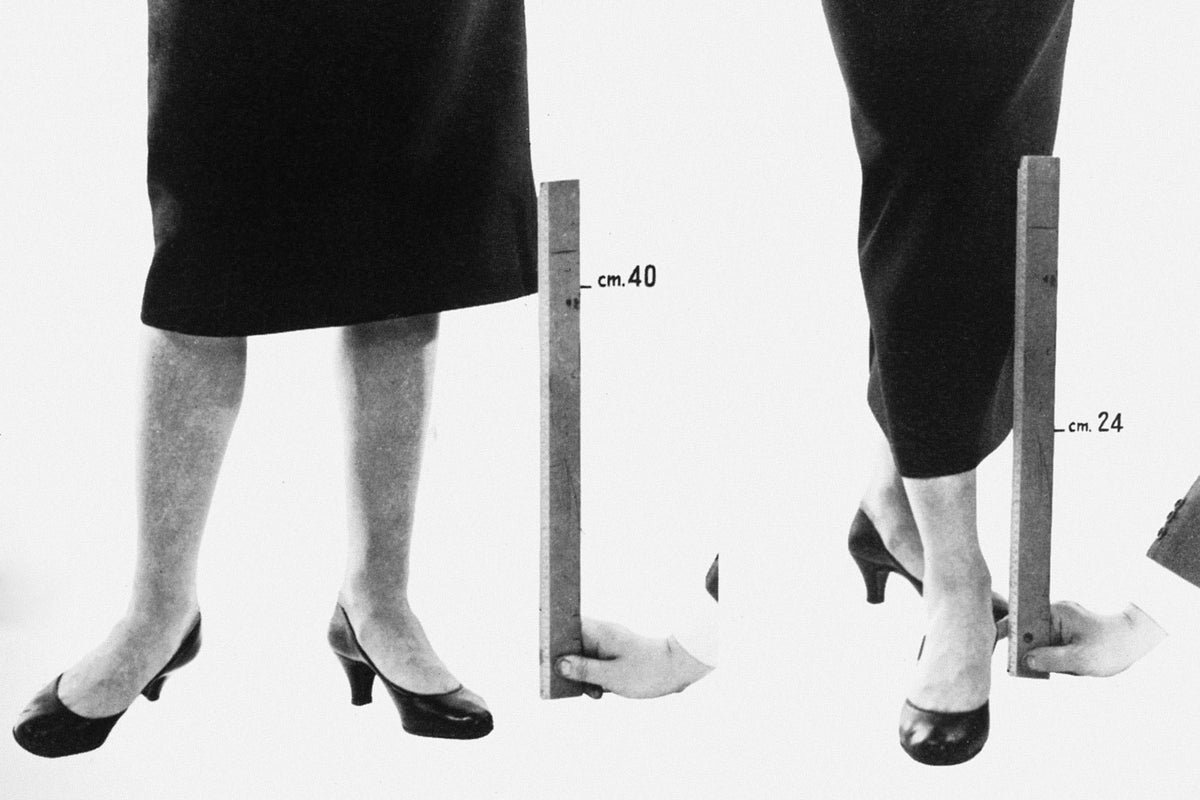When Dame Mary Quant’s miniskirt first cropped up on the pavements of Chelsea in the mid-1960s, it was as scandalous as it was stylish.
High-rise hemlines weren’t just a risqué fashion choice, they were a symbol of youth and freedom, ushering in a whole new era where politics, gender and social norms were totally re-examined.
So, to mark 60 years since the mini made its mark on Britain, here’s a look back at the skirt’s sartorial story throughout the decades…
View this post on Instagram
1910s
At the turn of the century, floor-grazing skirts were still favoured by Edwardians.
But when the First World War erupted in 1914, practicality trumped fashion, and women adopted lighter fabrics and shorter lengths suitable for work and uniform.
After 1915, ankle-length skirts were generally regarded as eveningwear, and for the next 50 years, what was regarded a ‘fashionable length’ would oscillate and even gave way to an economic theory called the ‘hemline index’.
1920s
In the 1920s, the flapper hemline hit on or above the knee, which was considered to be avant-garde and quite shocking.
It was in 1929 that the economist George Taylor published ‘Significant post-war changes in the full-fashioned hosiery industry’ where rising hemlines were seen as instrumental in fuelling the booming hosiery market of the 1920s.
This contributed to the theory known as the ‘hemline index’, which posited the fashionable length of a skirt rises with stock prices, and hence falls when the stock market is in trouble.
Throughout the Twenties, post-war prosperity gave rise to freer silhouettes like drop waists, and thus knee-skimming skirts became in vogue.
1930s and 1940s
At the end of the roaring Twenties however, a long period of recession known as the Great Depression hit the U.S and seeped into the rest of the western world.
Throughout the Thirties, in accordance with the hemline index, skirt lengths dropped as fewer people could afford hosiery, and conservative styles were favoured.
This wasn’t universal however as, in 1939, the beginning of the Second World War meant some skirts did become shorter, reflecting the need for less fabric and the increasing number of women entering the workforce, where they needed ease of movement.
1950s
As the Second World War drew to a close, the ‘Golden Age of Capitalism’ saw an unusual boom in wealth, employment and consumerism in Europe and north America.
The voluminous A-line, tea-length skirt became iconic, inspired by Christian Dior’s ‘New Look,’ skirts celebrated domestic opulence and represented a return to traditional and decorative ideas of femininity.
Instead of hemlines rising, they widened, allowing for fuller skirts with more fabric to be used.
Looking back on the reception of his debut collection, Dior said, “I believe it was due to the fact that I brought back the neglected art of pleasing.”
1960s
In the 1960s, the skirt had a new look once again, when British designer Dame Quant launched the ‘mini’ (named after her car, a Mini Cooper) – a skirt that sat six inches above the knee.
Dame Quant wasn’t necessarily the inventor of this style however, her French rival André Courrèges introduced a similar style in 1964, while Northumberland-born designer John Bates has also been credited with launching the cut.
Extremely short skirts, some as much as eight inches above the knee, became commonplace on the streets of Britain by the mid-Sixties. Young women who wore these short skirts were dubbed “Ya-Ya girls”, a term derived from “yeah, yeah” which was a popular catcall at the time.
This shocking trend also aligned with the hemline theory, as Britain’s GDP steadily grew, living standards rose and unemployment dropped throughout the decade.
1970s
The Seventies oscillated between mini A-lines and long, floaty maxis spurred on by ‘flower power’ politics. Hemlines fluctuated mirroring the volatile markets of the decade.
Tory Prime Minister Edward Heath oversaw an energy crisis, a financial crash and the country’s second miners’ strike in two years. And while Labour’s Harold Wilson got the country back to work, it came at the price of inflation at almost 30% and a bailout from the International Monetary Fund.
The return to longer skirts, therefore, was seen by some as a symbolic retreat from the optimism of the swinging Sixties.
As Britain faced power cuts, three-day weeks and rising unemployment, youth culture pushed back with romanticism and homemade or second-hand fashion.
The ‘DIY’ aesthetic of patchwork and block-print pieces echoed the growing distrust the public had for consumerism and big business, as vintage fashion became a cost-conscious choice for many.
1980s
In the 1980s, shorter skirts became popular again alongside the free market boom spurred on by Ronald Reagan in the U.S. The decade saw the return of the miniskirt, particularly the rara skirt – a short ruffled skirt, which is once again making a comeback today in 2025.
The economic despair of the late 1970s however helped fuel the punk movement. Designers like Vivienne Westwood and Malcolm McLaren redefined the skirt entirely – shredding it, slashing it, pairing it with safety pins and anarchic slogans.
There was also the more formal miniskirt of the 1980s, linked to the shoulder-padded suits of the time and the rise of women in the boardroom.
The short skirt – whether slashed or tailored – became a vivid statement of political and social defiance.
1990s
The 1990s saw minimalist slip skirts and relaxed, ankle-skimming lengths return thanks to the grunge movement.
The ‘less is more’ aesthetic dominated the runway, seen in designers like Calvin Klein and Jil Sander, and mirrored by high-street chains like Marks & Spencer.
The conservative silhouette arguably reflected the corporate sobriety in a time of economic restraint and recovery.
It was less about the skirt itself and more about how it was styled.
Flannel shirts were tied over floral midi skirts, while vivid black liner accessorised gothic lace, as an anti-fashion aesthetic born from an era of thrifting and rejection of Eighties excess.
By the mid-1990s, with Britain under New Labour, Cool Britannia in full swing and Tony Blair’s optimistic economic messaging dominating, skirt lengths started to rise once again.
The mini made a bold comeback – popularised by Clueless co-ords, Spice Girls pop culture and Britpop icons like Kate Moss.
It was playful and consumer-driven, coinciding with rising disposable income, the explosion of online high-street fashion – known as the ‘dotcom bubble’ – and a return to fast-paced markets.
2000s
By the 2000s, miniskirts got even more mini, as ultra-low rise waists and high-rise hems were the biggest trends of the decade.
Inspired by the likes of Sex and the City and Paris Hilton, skirts were shorter, shinier and more risqué than ever. They were emblematic of a tabloid-fuelled, celebrity-obsessed era where personal image was everything.
Retailers like Topshop, New Look and Miss Selfridge flourished, collaborating with ‘it’ girl names like Moss and Lily Allen.
However, when the global financial crisis hit Britain hard in 2008, fashion sobered up. Out went the frills and sequins and in came sleek and subdued silhouettes.
2010s
The pencil skirt and A-line skater skirt became wardrobe icons of the 2010s. Following the recession, ‘business casual’ became big, as many were streamlining their wardrobes to work both in and out of the office.
The shift in spending habits meant people were investing in more classic, durable pieces. This was evident at the end of the decade, as ‘quiet luxury’ and ‘cottage-core’ became some of the biggest trends, seeing a rise in milkmaid style and streamlined midi skirts.
Prominent figures like Meghan, Duchess of Sussex and pop culture media like Succession helped push this smart aesthetic.
While many economists at the end of the 20th century were sceptical about the hemline index, in 2010, two academics at the Erasmus School of Economics (Marjolein van Baardwijk and Philip Hans Franses) examined data of fashion magazines against measures of GDP from 1921 to 2009.
Their study argued that the hemline lengths were indeed an accurate reflector of economic fluctuation.
However, they found these changing trends in skirt length typically lag three years behind market shifts, rather than being an immediate effect.
Post Covid-pandemic, however, skirt styles are more varied than ever, reflecting a world of interconnected cultures which can no longer be defined by a single economic narrative.
Because of this, some are touting the asymmetric hemline to be a staple style of the decade, while others believe the rise in sheer and lace maxis is emblematic of our increasingly obfuscated society.
As we move through the 2020s, it’s clear that the skirt is no longer simply rising or falling with GDP, but splintering and mirroring a world of fragmented economies, aesthetics and identities.
The skirt seems to have become a symbol of who we are – and who we’re choosing to be.
#history #skirt #decades



